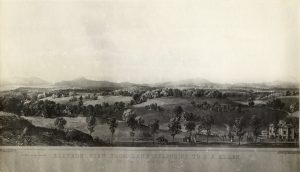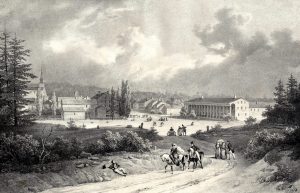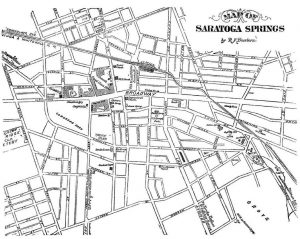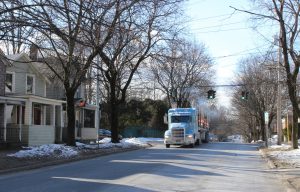
Engraving of North Broadway, 1850, Note 658 N. Broadway located on right
We use roads every day – whether we drive, bike, or walk along them. They get us to the places we need to go. We rarely think about their historic development and their impacts on our community. The first roads in early America were originally Indian and military trails. Trails allowed for farmers and traders to move about and sell goods. The development of roads caused businesses to spring up alongside them – inns, taverns, and other shops – which resulted in villages, towns, and cities being established – including Saratoga Springs. As modes of transportation evolved from the horse and carriage to the bicycle, to the automobile and semi-tractor trailer, roads also evolved – forever changing our built and landscape environment.

Circa 1829 Jacques Gerard Milbert illustration of Saratoga “Bains de Saratoga.” Saratoga Room, Saratoga Springs Public Library
On Monday, January 27th of 2014, the Saratoga Springs Preservation Foundation hosted the keynote speaker Tom Lewis who presented “Saratoga Springs: Streets, Highways, and Preservation” at our Annual Meeting at the National Museum of Racing and Hall of Fame at 191 Union Avenue. The meeting was free and open to the public.
Tom Lewis is a professor of English at Skidmore College and author of a number of books including “Divided Highways: The Interstate Highway System and the Transformation of American Life,” which was also made into an award-winning PBS documentary in collaboration with Florentine Films. He discussed the ways that our city’s road system contributed to its cultural and economic resurgence and the factors that threaten it.
Many do not realize that the construction of the first federal road, the National Road, began as early as 1811 providing a way for settlers to move west. The road leading from Maryland west to Illinois by 1834 was to be paved with broken stone since wagon wheels created ruts and even the smoothest of dirt roads were difficult to travel. While roads continued to be used, the railroad slowed their development. It was not until the popularity of the bicycle in the late 1800s that roads again were of national interest. The arrival of Henry Ford’s affordable Model T in the early 1900s spurred even greater interest in the construction of more roads. In 1956, when President Dwight D. Eisenhower signed the Federal Aid Highway Act into law, the transportation of goods and the American landscape would be forever changed. This act resulted in the construction of 41,000 miles of roads. While railroads had previously served as the primary way to move goods across the United States, semi-trucks now transport 70% of goods on our highways.

Dearborn Map of Saratoga Springs, 1872
The development of Saratoga Springs was clearly impacted by these national trends. For example, Interstate 87, which was part of the original establishment of the Interstate Highway System, allowed for easier travel to Saratoga Springs from New York City. Built in stages between 1957 and 1967, the Yaddo property was forever changed when a portion of the property was taken by eminent domain to construct the Northway. Tom Lewis will touch on the benefits I-87 brought to Saratoga Springs, which included the creation of Exit 14. As you exit the fast, modern highway and drive slowly along Union Avenue past the Saratoga Race Course and its grand houses, you are brought back to a different era.
Another example is the development of Route 50. Many do not realize that the four-lane road at Saratoga Springs Performing Arts Center was originally intended to bypass downtown Saratoga Springs and connect to the arterial that leads to Wilton. Not only would the construction of a four-lane bypass be the final nail in the coffin of a struggling downtown, it would have also destroyed Saratoga Springs’ oldest residential neighborhood, Franklin Square. In 1968, the threat of a bypass galvanized business and community members to save downtown and stop the bypass, which later resulted in the Saratoga Plan of Action.

Lone Truck on Van Dam, 2014
Tom Lewis will also discuss how roads can either enhance or detract from the experience of living in or visiting Saratoga Springs; how semi-truck traffic is impacting our community, specifically our historic building fabric. He will also suggest how we should think about altering our traffic patterns through changes in how we park, traffic calming devices, roundabouts, and walking and biking lanes.
At the Annual Meeting there will be the election of new Board members and officers as well as a brief overview of the Foundation’s achievements over the past year. People are encouraged to RSVP by calling (518) 587-5030 or emailing info@saratogapreservation.org. For more information about this event and others or to become a member, please visit our website www.saratogapreservation.org.
Founded in 1977, the Saratoga Springs Preservation Foundation is a private, not-for-profit organization that promotes preservation and enhancement of the architectural, cultural and landscaped heritage of Saratoga Springs.
This article originally appeared in The Saratogian.
